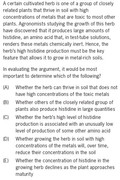My explanations to the above qn:
-------------------------------------------------------------------------------------
A herb is a part of closely related plants ---> It produces a particular amino acid 'H' that is tested to make metals in soil inert ----> it (herb) can survive in metal-rich soils ---> (Conclusion): So 'H' is the reason for it to survive in such soils.
We need to evaluate the argument here:
Something to be evaluated means - we should question whether the amino acid 'H' is the real reason behind its survival or is there another unnoticed factor present behind the survival.
A) Whether the herb can thrive in soils that does not have high concentrations of the toxic metals.
We are not comparing the survival of the herb in different types of soil. Our discussion is restricted to metal-rich soil and why it is able to survive in it.
B) Whether others of the closely related group of plants also produce Histidine in large quantities.
If yes, the other closely related plants also produce 'H', then it is possibly the reason for their survival in Metal rich soils ---> Testing all these plants will give us more proof (is a strengthener for the conclusion as it explains 'H' as the possible reason for survival)
If no, then there exists another factor ---> testing these plants will give us proof (shatters conclusion)
C) Whether the herb's high level of Histidine production is associated with an unusually low level of production of some other amino acid.
If yes, H produces another amino acid ---> what it that amino acid's role? Not clear (doesn't do anything to the conclusion)
If no, H doesn't produce another amino acid ---> So? How does this explain whether H is the reason behind the herb's survival? (Does nothing to the conclusion, again)
D) Whether growing the herb in soil, with high concentrations of metals will, over time, reduce their concentrations in the soil.
If yes, H reduces the metal concentrations ---> reducing metal conc is the reason for survival? (in the passage, H's role is given to us already, what we want to know is IF H is the REASON this happens, or is their another chemical or factor that initiates the production of H)
If no --- doesn't answer our question of H's importance
E) Whether the conc. of Histidine in the growing herb declines as the plant approaches maturity.
Our question isn't based on the timeline of H's production and its decline - questioning this does nothing to answer our question of H's role in the survival of the herb.
So my answer is:
B
---------------------------------------------------------------------------------------------------------
If any experts could kindly tell me whether my flow of thought/explanation(s) is on the right track or have i committed any mistakes, it'd really help me improve.
Thanks!

---------------------------------------------------------------------------------------------------------
In times of stress, fashion is always outrageous 




















